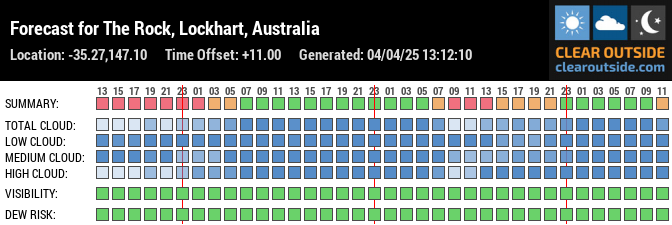Saturday SkyWatch

Saturday 13th December 2025
🌌 Saturday SkyWatch! 🌌
🌅 Sunset & Observatory Hours
- Sunset: 8:20 PM
- Nautical Sunset: 9:27 PM
- Astronomical Sunset: 10:07 PM
This Saturday we will be open from sunset till 12pm.
☁️ Weather & Viewing Conditions
B.O.M. Forecast for The Rock: http://www.bom.gov.au/places/nsw/the-rock/
To learn how to read the Clear Outside forecast page, follow this link: https://clearoutside.com/page/how_to_use/
🌙 Moon Phase
Tonight’s Moon is a Third Quarter Moon (37%) and will set at 2:11pm. This means that there will be darkness during viewing hours.
ℹ️ Other Information
Still bring a jacket if you get cold easily as the weather has been tricky lately and as always feel free to bring a picnic blanket, some snacks and non-alcoholic refreshments.
December is a good time for meteor showers so check the Full Skywatch for a list of events this week.
🔭 In the Sky Tonight
Note that just because these objects are in the sky at the moment, you may not always see them. Visibility is dependent on weather, moon brightness, atmospheric conditions, and equipment parameters. Check the weather and viewing conditions above, and if in doubt ask a friendly volunteer if you’re able to see an object in the night sky!
Prominent Constellations
Canis Major, Carina, Centaurus, Orion, Taurus, Vela, Pavo, Cetus, Aries, Vela, Fornax, Scuylptor.
Note: Crux is under 15° altitude during the spring / summer months
Bright Stars
Sirius, Canopus, Alpha Centauri, Rigil, Betelgeuse, Aldebaran, Adhara, Bellatrix, Elnath, Alnilam, Miaplacidus, Alnitak, Alsephina, Peacock, Diphda, Hamal, Markeb,
Open Clusters
Cr 70 (Orion’s Belt Cluster), M45 (Pleiades), IC 2606 (Southern Pleiades), NGC 1980 (The Lost Jewel of Orion), Cr 69 (Orion Cluster), NGC 2516 (Southern Beehive Cluster), NGC 981 (Coal Car Cluster), NGC 3114 (Hand Cluster), M 41 (Little Beehive Cluster), NGC 2547 (Golden Earring Cluster), NGC 2244 (Rosette Nebula), NGC 2477 (Electric Guitar Cluster), M 50 (Heart Shaped Cluster),
Globular Clusters
NGC 104 (47 Tucanae), NGC 6752 (Pavo Globular), NGC 362 (75 Tuc), M 30 (Jellyfish Cluster), M 79, NGC 2298
Galaxies
PGC 17223 (Large Magellanic Cloud), NGC 292 (Small Magellanic Cloud), M33 (Triangulum Galaxy), NGC 55 (String of Pearls Galaxy), NGC 300 (Sculptor Pinwheel Galaxy), NGC 6744 (face-on-spiral), NGC 1269 (Snow Collar Galaxy), M77 (Cetus A), NGC 7793 (Bond’s Galaxy), IC 1613 (Scarecrow Galaxy), M74 (Phantom Galaxy), NGC 1407 (Eridanus A Group), NGC 1232 (Eye of God Galaxy), NGC 1313 (Topsy-Turvey Galaxy)
Active and Interacting Galaxies
NGC 253 (Sculptor Galaxy), NGC 247 (Needle’s Eye Galaxy), NGC 1365 (Great Barred Spiral Galaxy), NGC 1566 (Doradus Cluster), NGC 1316 (Fornax A), NGC 1023 (Perseus Lenticular Galaxy)
Bright Nebula
M 45 (Pleiades), M 42 (Great Orion Nebula), NGC 1555 (Hin’s Variable Nebula), M43 (de Mairan’s Nebula), IC 2177 (Seagull Nebula), NGC 2467 (Skull and Crossbones Nebula), NGC 2070 (Tarantula Nebula), IC 434 (Horsehead Nebula), NGC 2032 (Lump Star Nebula), NGC 1909 (Witch Head Nebula), M 78 (Casper the Friendly Ghost Nebula), M1 (Crab Nebula), NGC 1579 (Northern Trifid Nebula). NGC 2238 (Rosette Nebula), NGC 2261 (Hubble’s Variable Nebula), NGC 1333 (Embryo Nebula), NGC 2170 (Angel Nebula),
Dark Nebula
B 22 (Taurus Dark Cloud), B33 (Horsehead Nebula),
Planetary Nebula
NGC 7293 (Helix Nebula), NGC 1360 (Robin’s Egg Nebula), NGC 2440 (Albino Butterfly Nebula), IC 418 (Spirograph Nebula), NGC 1535 (Cleopatra’s Eye Nebula)
Planets
Saturn
🪐 Upcoming Astronomical Events for this week
📅 13th – 14th December Geminids Meteor Shower Peaks
📅 16th December Comae Berenicids Meteor Shower Peaks
Note: All other astronomical events occurring this week are not visible from the Southern Hemisphere, or only visible through the daytime.
As always, don’t forget to look up wherever you are!
– The TRRO Team

